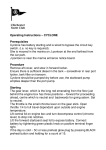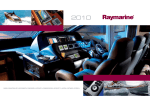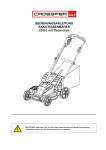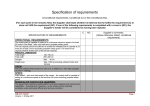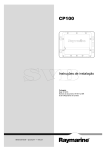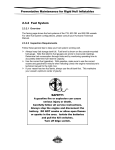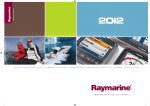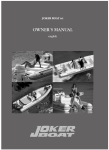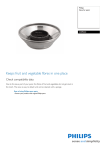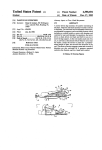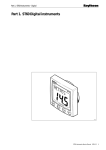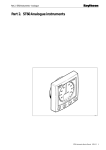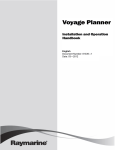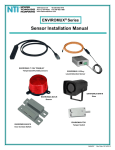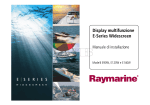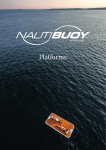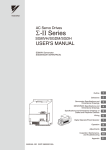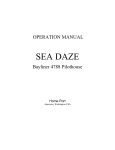Download Compliance matrix RIB 840-850
Transcript
Specification of requirements Requirements: Compliant (C) or Non Compliant (NC). For each point in the remarks field, the Supplier shall state whether he believes that he is compliant with the requirement (C) or does not comply with the requirement (NC). If a cross or a yes is entered in any of the (NC) columns below the Supplier’s tender will be considered non compliant and will be rejected. SPECIFICATION OF REQUIREMENTS C NC Supplier’s comments. (Unless otherwise stated: conditional requirement) Operational use The vessel is to be used globally in all climatic and weather conditions. Accordingly, due account must be taken of the operational use of the vessel as described below. The primary operational use will be boarding operations under the auspices of Danish Authority. The secondary operational use will be as an infiltration/exfiltration platform for operational personnel. The vessel shall be designed such that the fighting capacity and stamina of the passenger is not significantly diminished during transportation. The vessel shall be used for operational emergency response; for this reason, the vessel shall be of high quality in order to maximise the interval between repairs. Principal dimensions Total length min. 8.40 metres Total length max. 8.50 metres Hull length excluding air in pontoon, including motor installation. Overall width min. 2.40 metres Overall width max. 2.45 metres Hull width excluding air in pontoon. Height max. 2.50 metres With tower in locked position. From keel to highest point. Height max. 1.60 metres With tower in locked position. From waterline to highest point. Weight max. 4500 kg Complete vessel with full tanks. Crew The crew onboard shall consist of a vessel driver, a navigator and 8 men fully equipped (10 men ≈ 1500 kg). RIB-FKP 850 Final version 2011-09-01 Side 1 af 16 Speed Fully loaded (crew and total weight of the vessel), the vessel shall be capable of sailing at a continuous speed of not less than 45 knots. Must be able to accelerate from 0 to planing vessel within 20 seconds. Action radius The total sailed distance must be min. 200 nm at 35 knots. Seagoing and manoeuvring capabilities The vessel shall have good seaworthiness and good manoeuvring capabilities, including when reversing, as the vessel will operate under particularly difficult wind and weather conditions. In addition, the stern shall be sufficiently high as to prevent water from entering the vessel during ordinary reversing manoeuvres. Materials Materials shall be optimised with regard to strength and weight, taking into account the vessel’s operational use. All metal components such as fittings, pipe constructions, bolts, nuts, etc., shall be made from acid-resistant stainless steel, AISI 316. Structures and materials must be low in weight and sufficiently strong with regard to the vessel’s operational use. The hydraulic and fuel systems shall be designed in accordance with the manufacturer’s instructions. No clamp ring/die ring fittings or self-tapping screws shall be used in connection with joints on the vessel or its systems. A drawing – general layout and configuration – as well as material descriptions shall be enclosed with the tender as an appendix. Colour The complete vessel, including pontoon, control panel, etc., shall be finished in ORCA Military Grey or equivalent. In the event of deviation, a colour sample must be submitted with the tender. All cast components and structures shall be supplied body coloured. Radar echo Materials and design shall be chosen so that the vessel gives off the least possible radar reflection. As far as possible, round pipes must be used for towers etc. Structures must not be vertical or perpendicular to each other; the installed material must comply with this to the widest extent possible. Drawings shall be presented to Danish Defense Acquistion and Logistics Organization (DALO) prior to entering into a contract. RIB-FKP 850 Final version 2011-09-01 Side 2 af 16 Regulatory basis: ( The vessels shall fulfil the regulations in the SOLAS/LSA Code under the designation “Fast Rescue Boat”. Rigid inflatable. The boat need not fulfil the requirements for selfrighting. Deviations from the regulations shall be accepted in the following areas: 1. The Self righting system is not fitted. 2. The human load shall be calculated using the 150 kg per person for which the boat is designed. 3. The name, home port designations and call sign identifications are deleted and replaced by a different identification system determined by DALO. 4. Reflections on the bottom and pontoon are omitted. 5. Handrails on the bottom are omitted. Insofar as is possible, a taut hand-line or similar is placed below the pontoon edge, onto which people in the water can hold if the boat should capsize and float upside down. 6. Hoist hook of SVN standard type HENRIKSEN OFF-LOAD. 7. No separate VHF battery. Permanently installed VHF supplied from the vessel’s starter batteries. Certification: Certification in accordance with the required regulatory basis with specified deviations shall be carried out by one of the following independent competent bodies: 1. A “Notified Body” authorised in accordance with the EU Directive on the approval of marine equipment (MED). 2. A classification society authorised in accordance with the EU Directive on the approval of classification societies (Recognised Organisations). 3. An EU maritime administration (EU National Maritime Administration). 4. Another equivalent body which on the basis of a specific assessment can be accepted by the DALO authority section. Each individual boat shall be supplied with a certificate that confirms that the boat is of a type that fulfils the regulatory basis with the specified deviations. Using a numbering system, it shall be possible to link the certificate to the individual boat using a manufacturer’s plate with a corresponding number. Hull design The hull shall be optimised with regard to weight and strength – the plating shall be capable of withstanding slamming – taking into consideration the operational use (Sea State 5). The hull shall be designed as a full V-hull, approx. 24º-27º (transom angel) with spray edges, which is for ensuring a dry vessel but must not have a braking effect when the RIB-FKP 850 Final version 2011-09-01 Side 3 af 16 vessel lands after having been out of the water. The cover shall be completed as one whole flat part, where a natural step shall be designed in the stern, into which the bollard is integrated. Along the keel, the hull shall be reinforced with rubber or equivalent. The necessary reinforcements and fittings shall be embedded for all components to be fitted in the hull, flush with the deck. Rails for seats shall be fitted on deck. The deck shall be embedded in anti-slip coating. Drainage screw(s) shall be fitted in the transom to drain the internal hull. A transducer vault for echo sounding shall be built into the hull as far aft as possible, with good water contact when the vessel is planing. A manhole cover shall be fitted flush with the deck so that the transducer can be removed/fitted by the user. On the exterior of the hull, as far aft as possible with good water contact when the vessel is planing, two ground plates shall be fitted to starboard and port L = 180 mm W = 50 mm. The starboard ground plate shall be fitted for a tower with a cable of 10 square millimetres. The port ground plate shall be fitted with copper strip, copper litz braid/flat, as wide as possible but no less than 12 cm. The copper strip shall be pulled into the hull as close to the deck as possible from aft, port forward to stern and back on the starboard side, where it terminates in the radio room on as wide a connection rail as possible. The copper strip shall be soldered across its full width to the interior foundation plate, where the ground plate is fitted. The copper strip and the foundation plate shall be laminated into the hull as protection against external action. The vessel shall be designed with a closed transom of sufficient strength so that the points in this specification are fulfilled. This must be documented. A Whale type hand bailing pump or similar shall be fitted for draining the hull. The pump shall be fitted to the lower part of the tower and shall reach the deepest part of the hull by means of a hose with watertight bushing. Below the deck the necessary cables in the cable trays shall be pulled from the weather deck. Access to installations shall be level with the deck and it must be possible to remove/fit them immediately. The design shall make allowance for the user in connection with servicing/replacing components. RIB-FKP 850 Final version 2011-09-01 Side 4 af 16 The LMG mounting plate and foundation shall be manufactured and embedded with reinforcement(s) on the reverse of the deck in front of the front seat in the diametral plane as well as aft, in front of the transom, on the starboard side so that the gun carriage can be mounted directly on the deck. The size of the plate shall be sufficient for four M12 holes, 190 mm in diameter and 10 mm thick, to be drilled. A control measurement of the gun carriage shall be taken prior to manufacture. Weight of gun carriage and weapon 71 kg. Height approx. 1 metre. Two power joints shall be fitted in the diametral plane between seats in accordance with DALO instructions. Four stainless steel plugs with slots for power joints shall be supplied. Bushings in the hull shall be watertight and shall be approved in accordance with class/CE. However, a minimum of IP56 is required. A watertight storage compartment (forepeak) shall be designed. The storage compartment shall have room for the anchor, paddles and various hawsers. The anchor shall be secured on a moulded base and a means of securing it must be provided. Drainage and embedded pipes shall be fitted – must be resistant to petrol and oil products. Limbers are installed for the bilge pump kept farthest aft in the vessel. It shall be possible to clean the draining pipe with a cleaning wire. 1 x Bull-eye with a tensile strength of at least 5 tonnes to be mounted in the stern; to be documented. The transom shall be fitted with 1 x Bull-eye sized to ensure towing of a similar vessel at 35 knots, located in the diametral plane. The strength of the transom shall be documented. The complete hull, with a finished structure, including control panel, shall be pressure tested for impermeability at 0.25 bar. Fender Under the pontoon to starboard and port, a fender strip shall be fitted to protect the hull when pressure is applied to the pontoon. On the pontoon (starboard and port) and on the stern, a strong fender shall be fitted to protect the pontoon, color black. Strong fender reinforcement shall be fitted in the stern, from the lower edge of the stern piece to just above the waterline. Fuel tanks Fuel tanks – two loose tanks – to lie longitudinally – in succession – below deck as far forward as possible so that the vessel’s centre of gravity is not moved. RIB-FKP 850 Final version 2011-09-01 Side 5 af 16 The tanks shall be of equal size +/-10%. The tanks shall be equipped with venting with barrier, a drainage/drain valve, refuelling – in the deck – as well as the necessary number of cleaning covers. A means shall also be provided of emptying the tanks with a air compression pump. The tanks shall be made from a certified plastic material that complies with the certification, and the tanks including systems shall be certified for the following fuels: F34 – F44 – 56 – F75 – F76. The tanks shall be designed with anti-wash baffles. The tanks shall be secured and supported so that strong G-forces can be withstood without the tanks rupturing. Pontoons The pontoon shall be designed as follows: - stern made of fixed material. The stern must be flat approx. 500 mm and the fixed part must follow the hull to starboard and port so that the inflatable part can be integrated. - the starboard and port sides x shall be designed as inflatable and divided into compartments. The stern piece shall be designed as a removable fixed/flexible part filled with closed cell foam. It shall be possible to integrate and secure the pontoon onto the stern piece to starboard and port. The stern piece shall be designed in a durable material, polyurethane or equivalent. The pontoon shall be designed with at least 2 x 3 separate compartments in Hybalon, ORCA Military Grey 1670 dtx 1500 gr/m2 or equivalent. The pontoon must not be in contact with the water when the vessel is in neutral position in the water. The freeboard must be min. 10 cm high so that the shock effect is minimised before pontoons come into contact with the water while sailing in high seas. Each compartment shall be designed with an inflation and release valve of the Leafield C7 and A6 type. The valves shall be sunk flush in the pontoon and easily accessible for filling. The top of the pontoon shall be coated with an anti-slip coating in fields 2 x 3 pcs. as directed by DALO. Lifelines shall be fitted externally on the straight section of the pontoon’s starboard and port sides. At the front of the pontoon, 6 x rubber fittings and 2 x 50 mm D rings shall be fitted for winter sailing as directed by DALO. Tower The tower shall be designed as a pipe construction – with a minimum of radar reflection – angled so as not to come in contact with a second vessel/jetty when listing up to 45º. RIB-FKP 850 Final version 2011-09-01 Side 6 af 16 The tower shall be designed for appropriate strength (must be capable of withstanding vibrations as well as influences from sea/weather conditions), removable, not above pontoon height. The top section of the tower shall be tiltable forwards/backwards so that it does not exceed the max. height/length. A “bollard” shall be fitted on the lower part of the tower for mooring lines on the starboard and port sides. A back support shall be fitted for the vessel driver and navigator. Back supports shall be of the correct ergonomic design and adjustable up/down and forward/back. There shall be a small seat to flip out (driver and navigator) for use during calm sailing or during waiting periods. The tower shall be located aft of the control console. The following shall be located on the tower: • Radar dome. • GPS antenna. • 3 x antennae for communications. Antenna brackets shall be manufactured and fitted on the lower part of the tower in accordance with the template. The same antenna base should be used for all three antennae so that 3 frequency-specific antennae can be connected (e.g. 30–90 MHz, 90–120 MHz, and 120–512 MHz). All antenna cables shall be RG214. • Starboard/port lights, LED light. • Top and aft lights, LED light. • 1 x blue rotating flashlight 360°, LED light. • 2 x mobile projectors, xenon light. • 1 x Whale pump. The navigation light and blue flashlight must be used with the tower in the locked position. Surface treatment All painted surfaces shall comply with the specification of the paint manufacturer. The specification shall be submitted to DALO for approval. Control panel The vessel shall be equipped with a combined fixed control panel/map table, windscreen in a tubular frame with padded grab-handle, as well as tinted windows of splinter-free material. The combination of the design and material of the control panel shall support the lightest possible construction. The panel must be designed so that mechanical and electrical components can be serviced. RIB-FKP 850 Final version 2011-09-01 Side 7 af 16 The panel must be easy to remove and fit when removing the motor installation. When closed and sealed, the panel shall be watertight towards the deck. The panel shall be as wide as possible so that traffic from fore and aft is via the pontoon. The panel shall be located as far aft as possible in respect of the distance between the back supports and the panel (min. 880 mm) and the use of the gun carriage. In addition to the technical panels, the panel must contain compartments as follows: • Tubes for navigational charts open at the top. • Watertight communication compartments. Communication material must be removable as a complete part. • Excess volumes must also be fitted into compartments as agreed with DALO. Storage batteries shall be located either on an embedded plate or in approved boxes where they are properly secured. The top section of the panel shall be designed as a watertight compartment naturally angled aft and used for instruments, contacts, etc. Instruments shall be secured in a seawater-resistant aluminium plate screwed onto the panel; see drawing 100.501.000.001., which is for indicative purposes only. Instruments, etc., shall be located by agreement with DALO and the drawing shall be created. The following installation shall be fitted sloping recessed/flush with the front edge of the panel: 2 x operating panels for radio/intercom shall be located on the starboard/port side. The following installation shall be fitted sloping recessed/flush with the aft edge of the panel: Motor start, stop and emergency stop 2 x main switches for parallel coupling of storage batteries. 2 x sockets for radio/intercom shall be located in the diametral plane. The following installation shall be fitted recessed on the upper part of the panel: Standard multi instruments for motors. 1 x power outlet with circuit breakers for mobile GPS. Contacts for navigation lights, blue lights, projector, blue flashlight and instrument lighting, etc. 2 x radar and plotter screens. Echo sounder. 2 x sockets for radio/intercom shall be located in the diametral plane. Compass – Silva 125 F or similar – diametrically fitted. Screen, etc., shall be secured in a seawater-resistant aluminium plate screwed onto the panel; see drawing 100.501.000.002., which is for indicative purposes only. Screen, etc., shall be located by agreement with DALO and the drawing shall be created. RIB-FKP 850 Final version 2011-09-01 Side 8 af 16 Gear/gas box with integral power trim shall be located to starboard for the helm and the helm shall be located in the port side of the panel. The helm and gas/gear box shall be located at the correct working height. The following shall be installed in the panel’s communications compartment under the instruments, for motor and supply installation: • Circuit breakers • Terminal blocks • Main switches. Panel drawing complete with compartment, location of various components, etc., shall be submitted to DALO for approval. Navigation and communications equipment The items below from the company Raymarine or similar shall be supplied and fitted: • 1 x HD Radar dome 4 kW 24/48 RMP sweep E92142 • 2 x E120W Multifunction display E62223-EU • 1 x Raystar 125 Plus GPS antenna E32119 • 10 m radar cable, digital A55077D • 1 x STHS Switchbox E55058 • 1 x ST60+ Depth display A22002-P • 1 x Depth integral transducer E26001-PZ • 1 x ST60+ Flush mounting kit A25003-P • 1.5 m STHS cable for E-series display E55049 Navigation equipment to be deployed/installed in collaboration with the supplier company. Running in and adjustment to be undertaken by the supplier in connection with seagoing test. The communications component, to be located in the control console, comprises 5 components, approximate dimensions: Width = 500 mm, height = 300. At the time of placing the order, the equipment must be available for inspection for additional detailed project design. RIB-FKP 850 Final version 2011-09-01 Side 9 af 16 Lifting and transportation The vessel shall be capable of being lifted in a 4-point sling so that the vessel can be launched and brought on board by a crane, fully equipped. The vessel shall be fitted with Henriksen releasing gear which is to be placed in the centre of gravity; however, it must not be a disturbance to passengers. With the vessel fully loaded, including crew, the vessel shall be lifted horizontally with a 4-point sling and Henriksen releasing gear. The lifting sling and Henriksen releasing gear shall be approved for the total weight of the vessel as well as a load capacity of 1500 kg in accordance with the LSA Code. Lifting fittings shall be designed and approved so that the lifting point is as low as possible, SWL the weight of the vessel with personnel. Tests shall be conducted – highest factor – of lifting points in accordance with the LSA Code. In order to secure the vessel when transporting with a trailer or similar, it shall be equipped with four eyes (triangle or D-ring) well anchored into the hull. The eyes shall be placed with 2 x to starboard and 2 x to port, fore and aft respectively. Must be able to be changed and tightened by the user. Crew (passenger) seats 8 x seats that comply with the EU Directive 2002/447EC of 25 June 2002 of the European Parliament and Council of the European Union are placed in front of the control console. . Seats shall be fitted with snap locks for quick and easy dismantling/fitting in the rail system. Snap locks, article number F8500120 (Rocca, Sweden 37834834), rail system, article number 8500116. Rails shall be installed with care in the deck using Allen screws or similar so that they can withstand the impact of 2 x 4 men in high seas. 20 x eyes are supplied with the rail system together with a snap lock for securing cargo, with an opening of approx. 30 mm. Bollards 1 x strong retractable 2-armed bollard shall be deployed in the forebody of the vessel, among other things for towing/mooring. Design criterion: full load at 35 knots. The foundation shall be embedded into the vessel and implemented so that the bollard can be retracted flush with the deck. When retracted, the bollard must be capable of closing watertight to the hull. Loose equipment The vessel shall be equipped with and prepared for: • 4 x telescopic paddles. • Anchor with anchor line. RIB-FKP 850 Final version 2011-09-01 Side 10 af 16 • • • • Inboard diesels 2 x 2 kg. powder fire-extinguishers including brackets. 1 x tarpaulin PVC fabric 600 gr/m² covering the entire vessel. Colour: as vessel. 1 x tarpaulin PVC plastic fabric 600 gr/m² covering control console. Colour: as vessel. 1 x foot-operated pump including hose 2 x inboard diesels shall be installed in the vessel – EPA Tier 2 approved – with Z drive. Viewed from aft, the starboard propeller shall turn clockwise and the port propeller shall turn anticlockwise. If the vessel capsizes, the motors must stop automatically when the boat operator falls into the water. When restoring the boat, it must be ensured that no engine oil and cooling water has flowed into the cylinders and turbo charger. It shall be possible to start the motors immediately after any capsizing. The cooling water system must work through the heat exchanger and have inflow/outflow via the Z drive. It must be possible to thoroughly rinse the saltwater system with fresh water. The sea water pump must be self-priming and must work without water for at least 15 minutes. The outlet side of the exhaust system shall be via the Z drive or under water for minimising noise. The motor compartments shall be equipped with an automatic fire-extinguishing system, with automatic dampers. Wires from the gear/gas box shall be ducted in maintenance-friendly cable ducts from the motor to the console. The manufacturer/supplier shall be requisitioned for the calibration, programming and start-up of motors as well as associated systems. Hydraulic control Hydraulic/electrical control shall be fitted, suitable for the chosen Z drive. The following shall be supplied and fitted: • Helm pump(s), hydraulic/electric control for mounting in top plate on control console. • It is desirable that the helm is adjustable upwards/downwards and forwards/back. • Helm to be supplied in stainless steel with rubber coating, Ø 37 cm. • Emergency steering of the vessel must be possible. Fuel system, distance and fuel tanks Fuel tank capacities shall comply with the requirement for the sailed distance. RIB-FKP 850 Final version 2011-09-01 Side 11 af 16 Both motors shall be capable of extracting from all fuel tanks, together or individually. Valves to operate the fuel tanks shall be located such that the changeover can be accomplished from the manoeuvre site. Vent pipes from the fuel tanks shall be dimensioned so that they can: – vent during normal operation – vent while refuelling – Venting shall be dimensioned for a max. filling pressure. – The valves used shall be located for ease of use and have removable handles. – Vent pipes shall be fitted with barrier valves with removable handles. Water separation filters or equivalent shall be installed on both motors. The sailing distance shall be extendable using transportable fuel rubber tanks via the water separation filter which is to be located so that the user can change the filter and fit the tanks. Storage batteries The four storage batteries shall be used as follows: • 1 x per motor • 2 x for supply Each starter battery shall be connected via a main switch. Via the main switches, it shall be possible to start the motors on battery 1, battery 2 or both batteries simultaneously. It shall be possible to isolate supply and reserve batteries via a key main switch, independently. Scepters for distribution charging of supply/motor storage batteries shall be located in the interior part of the control console. A charging outlet for the Tystor 2-channel charger shall be fitted in the communications component of the console. Electrical installations Fuse board with circuit breakers for the following: – GPS – Radar – Communications equipment – Navigation equipment – Instrument lighting, echo sounder and compass – Plus four (4) available electrical groups located in the radio compartment under the RIB-FKP 850 Final version 2011-09-01 Side 12 af 16 instrument board together with terminal blocks. An electrical balance sheet shall be prepared covering the coincidence factor. The fuse groups must be adapted to the individual functions and marked unambiguously. Terminal blocks shall be marked in accordance with the circuit diagram. As far as possible, adapted original cables must be used, arranged in tie or cable trays. Outside the console, cables and wires shall be ducted in maintenance-friendly cable ducts, and, on towers, they shall be screened/protected from overload. It is desirable to install appropriately sized tubes between communications compartments and to the tower in order to facilitate replacement of antenna cables. Cables and wires on the tower and the control panel shall be connected with waterproof plugs so that it is easy to remove and fit the tower and control panel. Performance of the work All electrical installations shall be carried out using standard manufacturer-supplied cables with waterproof connectors and/or marine-approved cables. Installations/components shall be installed on a suitable watertight sheet, bracket, etc., in order to ensure adequate mounting and to protect cables. All installations shall be implemented with labelling at both ends; cables and wires shall be stored with a view to simplicity of layout and shall be secured to withstand the Gforces to which the vessel is subjected. All cables shall be fitted with waterproof connectors. All + cables shall be indicated by red heat-shrink. Other cables shall be indicated by black. All cable and wire dimensions shall be appropriate for their use and documented. Connections that are deemed to be non-standard shall be made using waterproof connectors. All open connection points shall be sealed using the product “Universal spray Super 6 Plus” from the company Berner, and “Dielectric Compound” from Quick Silver or equivalent. All penetrations of the hull and into closed spaces in the control console shall be watertight. All cables/wires shall be laid in cable trays, logically distributed, where they are secured/stripped carefully and appropriately. Electrical installations shall be located so as to be maintenance-friendly. It MUST be possible for the user to service/replace such installations, clearly marked at both ends and without any form of separation of the control console. Delivery RIB-FKP 850 Final version 2011-09-01 Side 13 af 16 Unless stated otherwise in this specification, a delivery shall be deemed as being a shipyard delivery (delivery and assembly). Documentation The following shall be included in the delivery as one copy, as well as in electronic format – DWG, Word, PDF – with one example to contain original documentation. Drawings shall be supplied in electronic format in AutoCAD version 2006. All documentation that is supplied under this point and in connection with this specification shall upon handover be deemed to be the property of DALO and may in future be used in connection with invitations to tender. At least the following drawings shall be supplied: ¾ General layout and configuration ¾ Specification of materials ¾ Embedded fittings, rails, etc. ¾ Body plan ¾ Line drawing ¾ Control console ¾ Tower and aft hoop ¾ Detail drawing of misc. fittings, etc. ¾ Fuel tanks ¾ Pipe/installation diagrams of the fuel system ¾ Pipe/installation diagrams of the hydraulic system ¾ Electrical diagrams (single-line and connection diagrams. At least the following certificates shall be supplied: ¾ The vessel ¾ Weight complete excluding fuel ¾ Materials and equipment used ¾ Compass ¾ Lanterns ¾ Fuel tanks and installation ¾ Lifting points and test loading ¾ Sling ¾ Hoses and pipes for fuel/hydraulic systems ¾ On bollard Calculation and tensile test ¾ Henriksen releasing gear At least the following information material shall be supplied: The following information manual(s) shall be prepared by the Supplier, irrespective of whether the equipment is supplied by DALO or the manufacturer. Information manual(s) shall cover all installed equipment. RIB-FKP 850 Final version 2011-09-01 Side 14 af 16 ¾ Drawings and bill of materials The bill of materials shall state the manufacturer’s article no. and include a field for NSN ¾ Technical equipment that is supplied with the components ¾ User manual with pictures and descriptions of the functions. ¾ User maintenance – daily, weekly, monthly and before and after sailing – of all installed equipment for which there are maintenance requirements. Produced in Danish. Scrapping criterion Because the principal dimensions are of vital importance to the vessel, exceeding these constitutes grounds for scrapping the vessel. Current spare parts The Supplier shall supply a list with a recommendation of current spare parts for the installed equipment. The list shall contain the original manufacturer’s name, address, etc., the manufacturer’s product designation and article number, as well as the Danish importer including article number. Makes/manufacturers All equipment that is supplied in connection with or for the vessel shall be documented with the original manufacturer, name, address, etc., the manufacturer’s product designation and article number, as well as the Danish importer including article number. Testing DALO is called in connection with type approval test and load tests, etc. Production plan to be forwarded, stating test procedure. Handover The vessel shall be supplied assembled, equipped and in operational condition. All materials, components and systems shall be tested in the presence of DALO and to DALO’s complete satisfaction. The Supplier shall prepare a technical control booklet in collaboration with DALO. The shipyard shall carry out a technical test voyage prior to delivery. Training The tender shall make provision of funds for the training of technical staff – 10 people, on motors, navigation equipment as well as vessel construction and maintenance. The cost of these courses shall be stated as a separate price in the tender. RIB-FKP 850 Final version 2011-09-01 Side 15 af 16 Equipment supplied by DALO Communications equipment. RIB-FKP 850 Final version 2011-09-01 Side 16 af 16
















